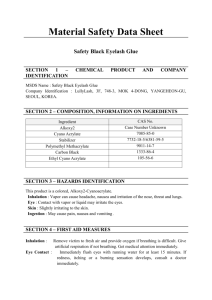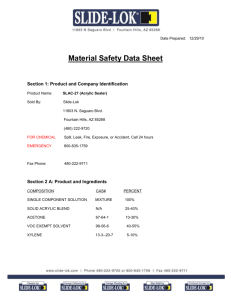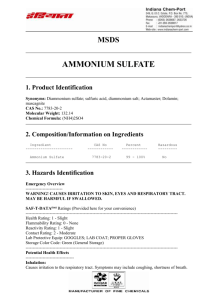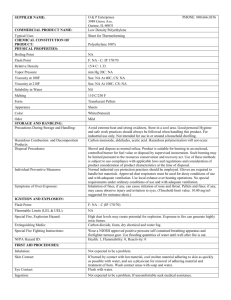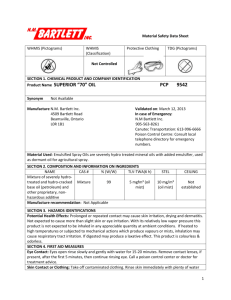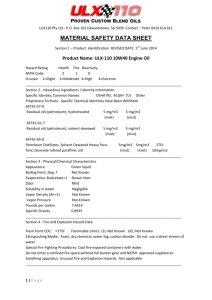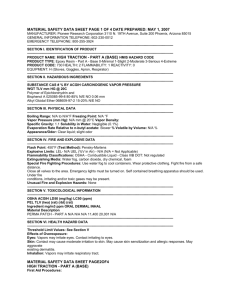section 2
advertisement
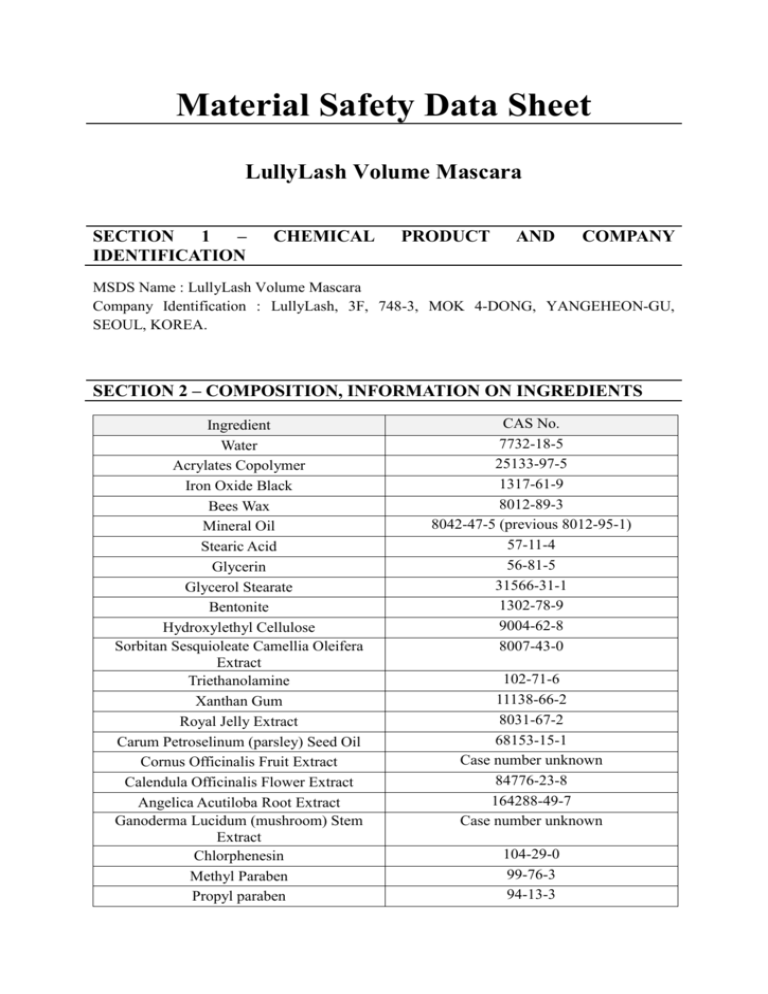
Material Safety Data Sheet LullyLash Volume Mascara SECTION 1 – IDENTIFICATION CHEMICAL PRODUCT AND COMPANY MSDS Name : LullyLash Volume Mascara Company Identification : LullyLash, 3F, 748-3, MOK 4-DONG, YANGEHEON-GU, SEOUL, KOREA. SECTION 2 – COMPOSITION, INFORMATION ON INGREDIENTS Ingredient Water Acrylates Copolymer Iron Oxide Black Bees Wax Mineral Oil Stearic Acid Glycerin Glycerol Stearate Bentonite Hydroxylethyl Cellulose Sorbitan Sesquioleate Camellia Oleifera Extract Triethanolamine Xanthan Gum Royal Jelly Extract Carum Petroselinum (parsley) Seed Oil Cornus Officinalis Fruit Extract Calendula Officinalis Flower Extract Angelica Acutiloba Root Extract Ganoderma Lucidum (mushroom) Stem Extract Chlorphenesin Methyl Paraben Propyl paraben CAS No. 7732-18-5 25133-97-5 1317-61-9 8012-89-3 8042-47-5 (previous 8012-95-1) 57-11-4 56-81-5 31566-31-1 1302-78-9 9004-62-8 8007-43-0 102-71-6 11138-66-2 8031-67-2 68153-15-1 Case number unknown 84776-23-8 164288-49-7 Case number unknown 104-29-0 99-76-3 94-13-3 Allantoin Hyaluronic Acid 97-59-6 9067-32-7 SECTION 3 – HAZARDS IDENTIFICATION This product is a colored, Solvent borne Cyano Methacrylate. Inhalation : Vapor can cause headache, nausea and irritation of the nose, threat and lungs. Eye : Contact with vapor or liquid may irritate the eyes. Skin : Slightly irritating to the skin. Ingestion : May cause pain, nausea and vomiting . SECTION 4 – FIRST AID MEASURES Inhalation : Remove victim to fresh air and provide oxygen if breathing is difficult. Give artificial respiration if not breathing. Get medical attention immediately. Eye Contact : Immediately flush eyes with running water for at least 15 minutes. If redness, itching or a burning sensation develops, see a physician. Skin Contact : Remove contaminated clothing/shoes and wipe off excess from skin, Wash exposed area with soap and water. If redness, itching or a burning sensation develops, seek medical attention. Ingestion : Seek medical attention immediately. SECTION 5 – FIRE-FIGHTING MEASURES Extinguishing Media : Use dry chemical, carbon dioxide, foam or spray as appropriate for surrounding fire. Fire-Fighting Instructions : Do not enter any enclosed or confined fire space without full protective equipment, including self-contained breathing apparatus to protect against the bazardons effects of combustion products and oxygen deliciency. SECTION 6 – ACCIDENTAL RELEASE MEASURES Spillages : Dike and absorb with inert material such as sand and remove all liquid with the use of a vacuum system. If unable to remove liquid, then begin to absorb with sand, saw dust or commercial absorbent, and scoop up and place in containers for proper disposal. Keep spills and cleaning runoff out of the municipal sewers and open bodies of water. Decontaminate all clothing and the spell area with a detergent and large amounts of water. Large Spillages : Use same procedure as small spill. SECTION 7 – HANDLING AND STORAGE Handling Precautions : Avoid skin or eye contacts. Avoid prolonged or repeated breathing of vapors and mists. If spilled on clothing, launder before reuse. Do not take internally. Use only in a well ventilated area keep out of the reach of children. Storage Requirements : Keep from freezing. Product will coagulate. Keep container tightly closed when not in use. Don not get in eyes, on skin or on clothing. Monomer vapors can be evolved with material is heated. Containers, even those that have been emptied, will retain product residue vapors and are subject to proper waste disposal, as above. SECTION 8 – EXPOSURE CONTROLS/PERSONAL PROTECTION Protective Clothing/Equipment : The use of gloves impermeable to the specific material handled is advised to prevent skin contact and possible irritation. Use Chemical Goggles if splashing may occur. SECTION 9 – PHYSICAL AND CHEMICAL PROPERTIES Physical State : Liquid pH : N/A Water Solubility : N/A Boiling Point : 100℃ SECTION 10 – STABILITY AND REACTIVITY Hazardous Decomposition Products : Thermal decomposition may yield acrylic monomer, carbon monoxide and carbon dioxide. Unidentified organic compounds in fumes and smoke may be formed during combustion. SECTION 11 – TOXICOLOGICAL INFORMATION Toxicity: Skin contact may cause burns. Bond skin rapidly and strongly Skin and eye irritant Routes of Entry: Inhalation (Yes), Skin (Yes), Ingestion (Yes) Carcinogen etc : See section 3 SECTION 12 – ECOLOGICAL INFORMATION No data available. SECTION 13 – DISPOSAL CONSIDERATION Disposal : Dispose of unused product or contaminated product and materials used in cleaning up spills or leaks in a manner approved for this material. Consult appropriate federal, state and local regulatory agencies to ascertain proper disposal procedures. SECTION 14 – TRANSPORT INFORMATION CLASS: Unlisted UN Number: Unlisted SECTION 15 – REGILATORY INFORMATION CA Proportion 65 : No California proposition 65 chemicals are known to be present. SECTION 16 – OTHER INFORMATION To the best of knowledge, the information contained herein is accurate. However, neither our company nor any subsidiaries assumes any liability whatsoever for the accuracy or completeness of the information contained herein. All materials may present unknown.
